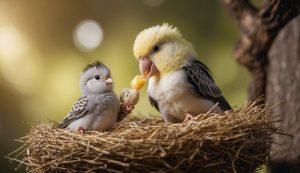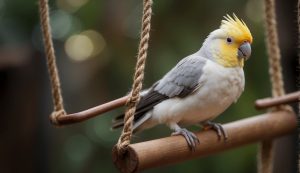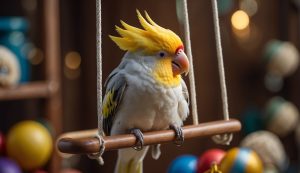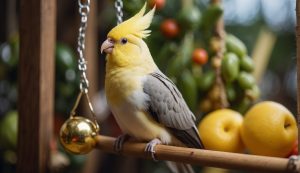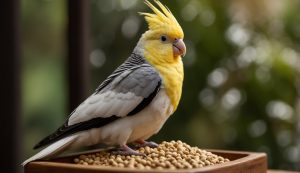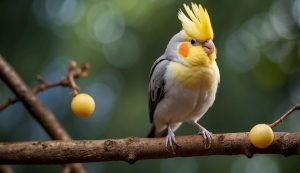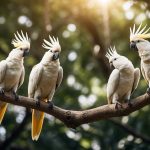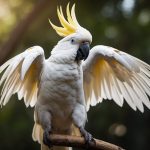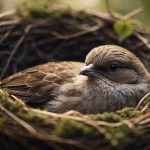How Far Can Cockatiels See? – Insights into Their Visual Range

Cockatiels, with their scientific name Nymphicus hollandicus, are fascinating creatures endowed with vibrant personalities and a captivating appearance.
When observing these birds, one might wonder about their visual capabilities, especially considering their life in the wild versus captivity.
Cockatiels boast a vision that is quite keen, allowing them to navigate their surroundings, recognize flock members, and spot predators from a distance. This acute eyesight is essential for their survival, as it aids in foraging for food and avoiding potential dangers.
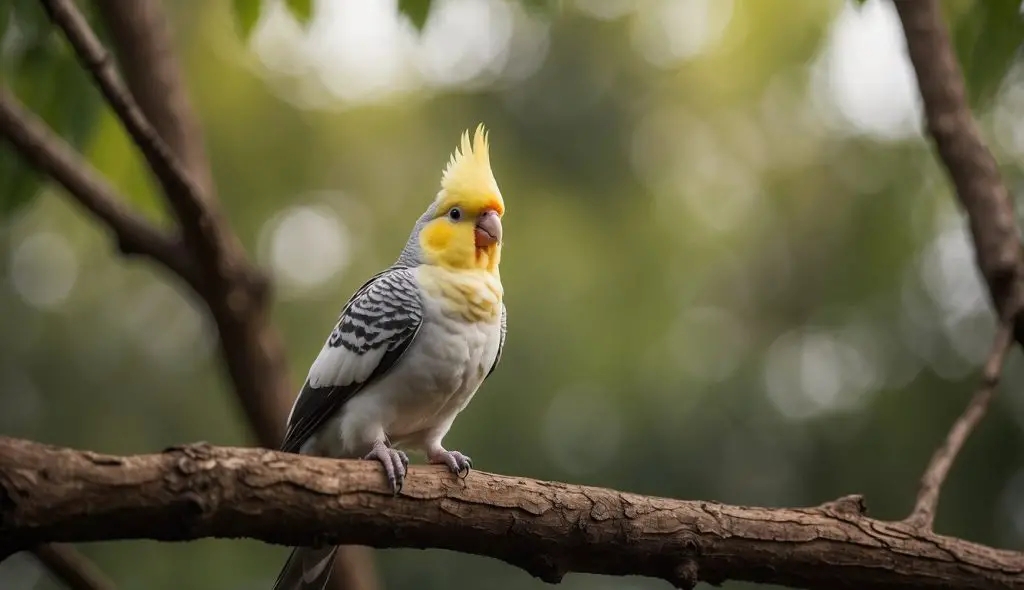
These birds are not just visually acute; they have a visual spectrum that includes a range of colors.
This ability to perceive colors aids them in their daily activities, such as selecting mates, finding food, and interacting socially with other cockatiels and their environment.
Understanding the scope of their vision helps us create better environments for them in captivity, ensuring they can engage with their surroundings in a way that is natural and fulfilling to their specific needs.
Key Points…
- Cockatiels have a keen vision that is crucial for their everyday survival and interactions.
- Their eyesight includes the ability to see a wide spectrum of colors, influencing their behavior and communication.
- Recognizing the importance of vision in cockatiels can guide us in providing better care and enriched environments.
Table of Contents
Cockatiel Vision Explained
In exploring the capabilities of a cockatiel’s vision, we’ll dive into how they see the world. From the vibrant spectrum of colors to their panoramic view, there’s much to appreciate about how these birds perceive their environment.
Understanding Cockatiel Eyesight
Cockatiels fall into the category of birds with highly developed visual abilities, pivotal for their survival and behavior. As a species that relies on visual cues, their eyesight is adapted to discern fine details.
This keen perception aids in foraging, avoiding predators, and interacting with their flock.
Color Perception and Ultraviolet Light
Cockatiels can perceive colors differently than humans. Their vision extends into the ultraviolet (UV) range, which is invisible to us. Here is a breakdown of their color vision capabilities:
- Visible Spectrum: Like humans, they see the traditional range of colors.
- Ultraviolet Light: Adds an extra dimension to their perception, vital for mate selection and food foraging.
Field of View and Depth Perception
To process their surroundings, cockatiels have a wide field of view. Here’s how their vision is arranged:
- Lateral Eyes: Provides a broad field of view, great for spotting predators.
- Binocular Vision: The overlap in front allows for depth perception, which is crucial for navigating through foliage and assessing distances during flight.
Physical Characteristics of Cockatiels
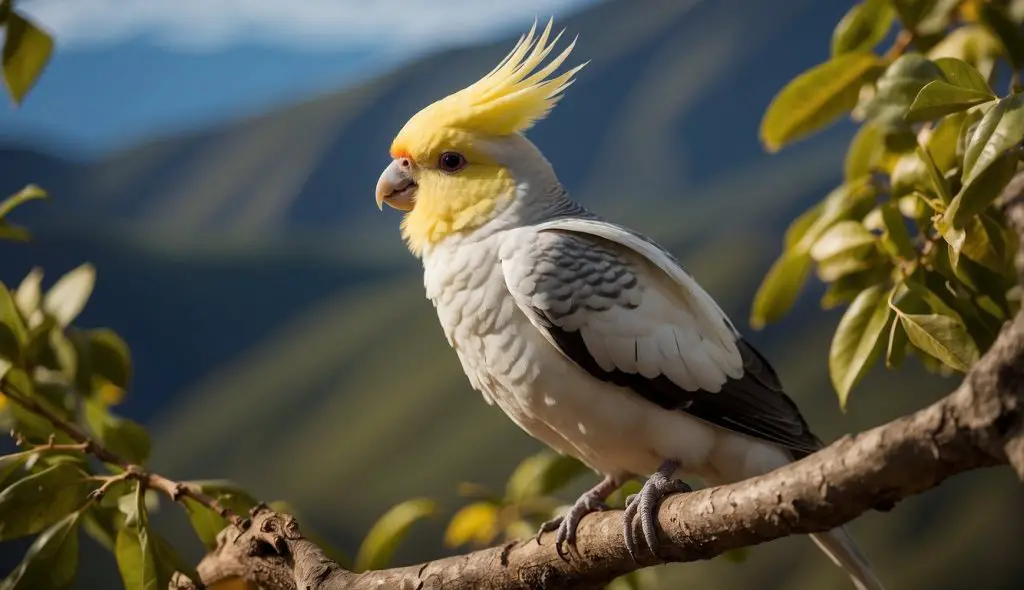
Cockatiels are fascinating creatures, and their physical traits are distinctive and charming to bird enthusiasts. As I walk through the specifics, notice how these features make cockatiels unique among other bird species.
Size and Appearance
Cockatiels, also known by their scientific name Nymphicus hollandicus, are relatively small compared to some parrot species but are still notably larger than the common parakeet. On average, they reach a size of 12 to 13 inches from beak to the tip of their tail feathers.
- Weight: Approximately 80 to 120 grams
- Color: Mostly grey with touches of white and vibrant yellow around the head
- Sexual Dimorphism: Males often exhibit brighter yellow stripes on their faces, while females may have more understated hues.
Tail Feathers and Beak Features
The tail feathers of cockatiels are quite conspicuous because of their length, making up half of their total body length. These tail feathers are elongated and help with balance and flight.
- Tail Design: Stepped and tapered, enhancing aerodynamics
The beak of a cockatiel is not just for eating; it’s a multifunctional tool. It’s strong, curved and is suitable for cracking seeds, which is a primary part of their diet.
- Beak Color: Light grey to dark grey, sometimes almost black
- Utility: Aids in climbing and as a third limb when navigating through branches
Behavior and Communication
In my experience with cockatiels, their behavior and communication are integral to understanding these engaging birds. They exhibit a range of vocal and physical expressions that reveal their social nature and how they interact with their environment.
Social Interaction with Humans and Other Birds
Cockatiels thrive on social interaction, be it with humans or other birds. When in a healthy environment, these birds are notably playful and enjoy engaging with their human caretakers.
It’s not uncommon for them to seek out play, whether it be with toys, simple games, or direct interaction with humans.
In the company of other cockatiels or birds, they often form flocks or pairs, which are essential to their social structure and emotional well-being. Their tendency to be quiet during the night and alert during the day matches their human companions’ routine, which aids in fostering a companionable bond.
Cockatiel Communication: Vocalization and Body Language
Cockatiels communicate extensively through vocalizations and body language.
Vocal cues can include various sounds such as whistles, soft chirps, and sometimes attempts to mimic human talk. These sounds serve different purposes – a cheerful whistle can indicate contentment, while a loud call may be an alert of distress or to gain attention.
Body language is equally telling; for instance, a raised crest might signal interest or excitement, while hissing is a clear sign of irritation or fear.
Night frights are a particular behavioral phenomenon where cockatiels might startle and thrash in their cage at night, often requiring a calm and soothing response from their human companions to settle down.
Cockatiel Care and Environment
As a loving cockatiel guardian, I understand that creating a secure and engaging environment is essential for my bird’s well-being. Let’s discuss exactly how to set up their habitat, what to feed them, and how to keep them physically and mentally stimulated.
Habitat Requirements and Cage Setup
Cockatiels need a spacious cage to live happily and healthily; the minimum size I recommend is about 24 inches wide, 24 inches deep, and 30 inches tall.
Equip the cage with horizontal bars to allow climbing, which is a great form of exercise.
I always ensure there are multiple perches of different sizes and materials to help keep my cockatiel’s feet healthy and provide variety.
It’s vital to avoid overcrowding the cage with toys, maintaining a balance between enrichment and open space for flight.
I place the cage in a location free from drafts but where they can still be part of the family’s daily activities to foster social interaction.
- Cage Dimensions: Minimum 24x24x30 inches
- Perches: Varied sizes; natural wood recommended
- Location: Family area, away from drafts
Diet and Nutrition
A balanced diet plays a crucial role in increasing the life span and overall health of cockatiels.
I primarily feed a premium seed mix specific for cockatiels but always complement it with fresh vegetables such as broccoli, carrots, and leafy greens, which provide essential nutrients.
Additionally, cockatiels also enjoy the occasional piece of fruit. It’s vital to ensure their food is clean and fresh, so I replace uneaten fruits and veggies daily to prevent spoilage.
- Main Diet: Premium cockatiel seed mix
- Vegetables: Broccoli, carrots, leafy greens (daily)
- Fruit: Occasionally (remove if uneaten)
Exercise and Enrichment
Cockatiels are naturally playful and require daily exercise and mental stimulation to maintain their well-being.
In my home, I have a variety of toys to encourage natural behaviors such as chewing, foraging, and exploration. For instance, I provide chew toys made of safe woods and materials designed for parrots to satiate their need to chew.
Interactive toys keep them engaged, and simple puzzles can enhance their problem-solving skills.
Of course, daily out-of-cage time in a safe, cockatiel-proofed area is non-negotiable for my bird’s health and happiness.
- Toys: Chewable, interactive, puzzles
- Daily Exercise: Out-of-cage time in a safe area
Understanding Cockatiel Maturity and Breeding
In my experience with pet birds, understanding the signs of maturity in cockatiels is vital for responsible breeding. Knowing when and how they breed can also inform you of the expected clutch size and the health of both the parents and offspring.
Identifying a Mature Cockatiel
I can generally tell a cockatiel is mature and ready to breed by its age and physical characteristics. Typically, cockatiels reach sexual maturity around 6 to 12 months, but I prefer to wait until they’re at least 18 months old to ensure they’re fully prepared for the breeding process.
Males often display more vivid colors and may have a brighter yellow head and brighter orange cheek patches but these features can vary with mutations like lutino, pied, pearl, and cinnamon. A mature male may also exhibit behaviors such as singing, strutting, and mating dances.
Females might display less vibrant colors and have barring on the underside of the tail feathers, although again, this can differ based on their specific mutations.
The Breeding Process and Clutch Information
Once I’ve identified mature cockatiels, I observe their interaction to ensure they’re compatible mates—which can significantly affect reproductive success.
A proper nesting environment is key for a successful breeding process. Cockatiels generally lay their eggs within a week after mating. They can lay one egg every other day until the clutch size is complete, usually consisting of 4 to 6 eggs.
It’s essential to monitor the pair during this period as stress and improper care can impact not just the current breeding cycle but future ones as well.
I ensure they have a balanced diet enriched with calcium to support egg development, and I maintain a peaceful and secure environment for them to rear their young.
Frequently Asked Questions
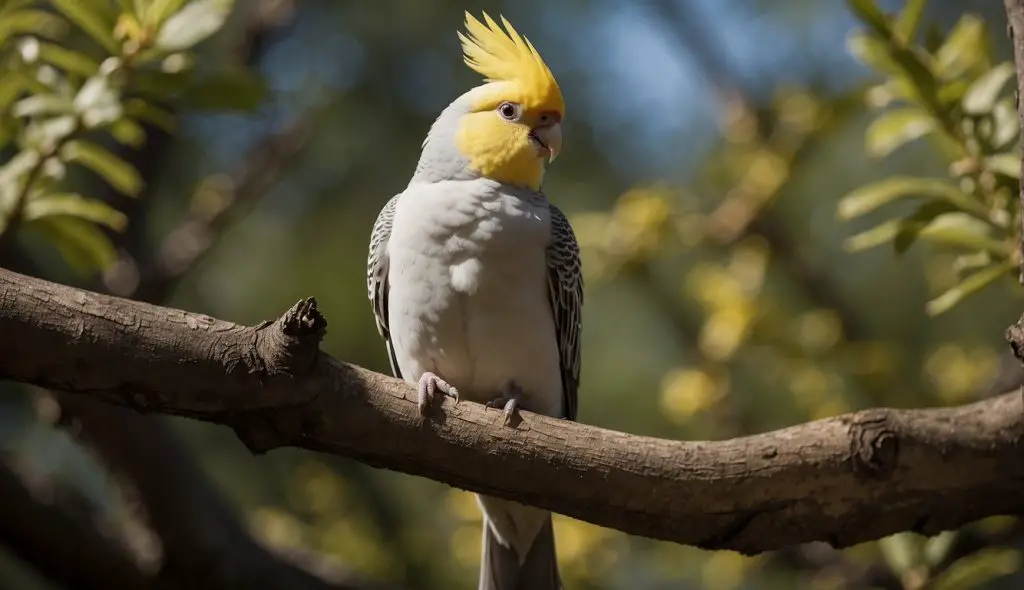
In this section, I’ll cover some of the most common queries regarding the visual capabilities of cockatiels.
What is the visual range of cockatiels during the nighttime?
Cockatiels, much like many other birds, have limited night vision. I understand they rely on daylight and their vision is not as sharp in the dark, which is why they aren’t typically active at night.
In what ways do cockatiels perceive their human companions?
My knowledge tells me that cockatiels can recognize and differentiate between their human companions.
They notice details like facial features and clothing, which helps them identify and bond with individuals.
How do cockatiels interpret their surroundings?
Cockatiels have a field of view that allows them to see their environment clearly and from different angles.
With eyes positioned on the sides of their head, I’m aware that they have excellent peripheral vision to monitor their surroundings effectively.
Are cockatiels able to distinguish different colors, and if so, how?
Yes, cockatiels can distinguish colors. They can see a range of colors, possibly even into the ultraviolet spectrum, which exceeds my color perception capabilities.
What kind of color preferences do cockatiels have?
It’s hard to generalize a color preference for cockatiels as it can vary. However, bright, and possibly reflective or UV-light-reflecting objects may catch their interest more due to their vision abilities.
How should one search for a cockatiel that has accidentally flown away?
When looking for a lost cockatiel, I’d begin by checking nearby trees or high points where they might rest or survey the area.
Since they can be attracted to familiar sounds or calls, playing recordings or calling out might coax them into revealing their location.

